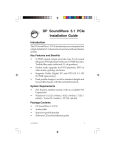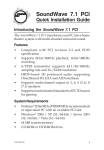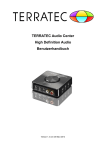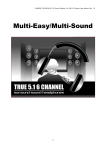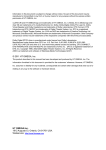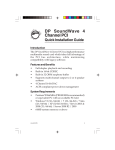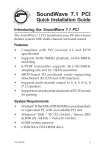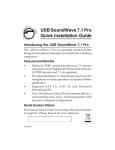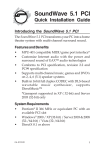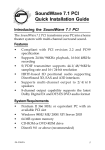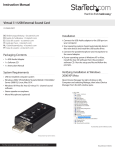Download Siig DP SoundWave 7.1 PCIe
Transcript
DP SoundWave 7.1 PCIe Quick Installation Guide Introduction The DP SoundWave 7.1 PCIe transforms your computer into a high-definition 7.1 channel surround sound home theater system. Key Features and Benefits • • • • • Audio output via optical S/PDIF and/or 3.5mm stereo connectors Supports 7.1 channels audio output up to 192K sampling rate Supports high resolution 24bit PCM Codec Total of four playback DMAs and three recording DMAs Installs in standard height or low profile chassis with included brackets System Requirements • • PCI Express enabled system with an available PCI Express slot Windows® 8 (32-/64-bit) / 7 (32-/64-bit) / Vista (32-/64-bit) / XP (32-/64-bit) Package Contents • • • • DP SoundWave 7.1 PCIe Audio adapter cable Spare low profile bracket Software CD & quick installation guide 04-0873A 1 Layout Line In Digital In Digital Out Center (yellow) Front MIC (green) (red) Back surround (grey) Surround (black) Front panel audio connector Figure 1: Layout • • • • • • • 2 LINE In: This connector provides analog stereo line-in function Digital In: This connector provides digital input function Digital Out: Connect to digital input of an external audio device via Digital S/PDIF optical cable (cable not included) Center Out (yellow): This connector provides center audio output Front Out (green): This connector provides front audio output, or you can connect one set of stereo speakers MIC IN (red): This connector provides microphone-in function Back Surround (grey): This connector provides back surround sound output • • Surround (black): This connector provides surround sound output Front panel audio connector: Connects to your system's front panel audio connector (optional). Refer to the next section for pin assignment Pin Assignment NC AGND MIC2* NC MICPWR Line out_R NC NC Line out_L * Refer to the position of Pin 1. Figure 2 Hardware Installation Note: For low profile systems, replace the currently mounted bracket with the included low profile bracket. General instructions for installing the card are provided below. Since the design of computer cases and motherboards vary, refer to your computer’s reference manual for further information, if needed. Static Electricity Discharge may permanently damage your system. Discharge any static electricity build up in your body by touching your computer case for a few seconds. Avoid any contact with internal parts and handle cards only by their external edges. 3 1. 2. 3. 4. 5. 6. 7. 8. Turn OFF the power to your computer. Unplug the power cord and remove the computer cover. Remove the slot bracket from an available PCIe slot. Carefully align the card to the selected PCIe slot, push the board down firmly, but gently, until it is well seated. Replace the slot bracket holding screw to secure the card. Connect one end of the audio cable from your CD/DVD-ROM to the CD-In on the soundcard. Replace the computer cover and reconnect the power cord. Make your speaker and device connections, then complete the driver installation on the next pages. Driver Installation Windows 8 (32-/64-bit) / Windows 7 (32-/64-bit) 1. 2. 3. 4. 5. 4 Install the board and boot up Windows. At the Windows desktop, insert the driver CD. Close the CD autoplay window if prompted. For Windows 8: Click Windows key and R, type D:\setup.exe, click OK. (Change D: to match your CD/DVD-ROM drive letter) For Windows 7: Click Start. At the Search programs and files, type D:\setup.exe, press Enter. (Change D: to match your CD/DVD-ROM drive letter) At the User Account Control, click Yes. At Welcome to the InstallShield Wizard for C-Media High Definition Audio Device, click Next. 6. 7. 8. 9. Select I accept the terms of the license agreement, click Next. Click Install. At the Xear Audio Center, click OK. Click Finish to restart the computer. Windows Vista (32-/64-bit) / XP (32-/64-bit) 1. 2. 3. 4. 5. 6. 7. 8. 9. Install the board and boot up Windows. Click Cancel at the Found New Hardware. Skip this step if not prompted. At the Windows desktop, insert the driver CD. Close the CD autoplay window if prompted. Click Start, Run. Type D:\setup.exe, click OK. (Change D: to match your CD/DVD-ROM drive letter) At the User Account Control, click Allow. For Windows, XP, skip this step. At Welcome to the InstallShield Wizard for C-Media High Definition Audio Device, click Next. Select I accept the terms of the license agreement, click Next, then click Install. At the Xear Audio Center, click OK. Click Finish to restart the computer. 5 To Verify Windows Installation 1. 2. Check Device Manager to verify installation. Windows 8 / 7 / XP: Right click Computer or My Computer, click Manage, then click Device Manager. Windows Vista: Right click Computer, click Manage, click Continue, then click Device Manager. Double click Sound, video and game controllers, C-Media High Definition Audio Device should be displayed. Uninstalling the Soundcard Driver If you want to uninstall the driver from the system, it's best to do so before removing the card from the system. Go to Control Panel, Programs and Features. Select the C-Media High Definition Audio Device option, click Uninstall and follow the on screen instructions to uninstall the driver. Xear Audio Center Xear Audio Center is an easy to use audio utility that allows you to adjust audio outputs, recording, sound effects and surround sound support to meet your needs. Quick Start Icon After successful driver installation, double click the Xear Audio Center icon in the taskbar or on the desktop to initiate the program. If the icon doesn't appear as a shortcut, go to the program folder in which you installed the program and double click on the utility icon. 6 Control Panel 3 1 2 4 Figure 3 • 1 - Master Volume Adjusts the volume of all output device through this master volume bar. Click the speaker icon on the right side to mute all the output devices. Click the icon again to unmute all the output devices. Mute/unmute Figure 4 • 2 - ASIO & EX button ASIO (Audio Stream Input Output). Click the ASIO button on the main menu to see Bit-Depth and Latency value. Change the default value, if needed, then click OK to save the change. See Figure 5. 7 Bit-Depth Latency Figure 5 EX (Xear 3D EX): C-Media Xear3D EX technology provides a complete and fully backward compatible 3D audio interface. Click EX button to enable the Xear 3D EX function. Click EX button again to disable it. NOTE: This function is not available in Windows XP. • 3 - Function Panel / Profile Panel Click the switch button to change between Function Panel and Profile Panel. Refer to Figure 6 and Table 1 for the descriptions of each abbreviation. Output default device Speaker numbers Input default device Sample rate Audio input effect indicator Figure 6 8 Switch button Audio output effect indicator Table 1 Profile Panel: Select the preset profile modes by clicking on the button. Once the mode is selected, there will be a green check on the right-down corner. See Figure 7. Click + to create a new profile by yourself. Click to delete a profile. NOTE: Not all the modes are available under different output types. 9 + - Figure 7 • 4 - Audio Output / Input Selections Audio Output Selection: Select Speakers or S/PDIF Out in the left side bar of the main menu. For analog audio output, click Speakers, for digital S/PDIF audio output, click S/PDIF Out. Speaker Headphone S/PDIF Out NOTE: Only when a device is connected to the front panel audio connector will the Headphone selection button be available. Audio Input Selection: Based on your different type of audio inputs, select Mic, Line-In, S/PDIF In or Stereo Mix in the left side bar of the main menu. Mic Line-In S/PDIF-In Stereo Mix Speakers Output Audio Selection 1. 10 Click Speakers icon in the left side bar of the main menu. Once Speakers is selected, a green check will appear below the Speakers icon. 2. Right click on the Speakers icon and select a function from the list. See Figure 8 and Table 2 for more information. Figure 8 Function Function Description Volume Control Volume settings for all audio channels Speaker Settings Select one speaker setting: Stereo, Quadraphonic, 5.1 Surround or 7.1 Surround Sample Rate Select one sample rate from 44.1 KHz, 48 KHz, 96KHz, 192KHz, and select Bit Depth from 16 bits & 24 bits Equalizer Click "Equalizer", and check the "Enable Equalizer" box to adjust the EQ. You can adjust the EQ manually, or you can click the buttons below for the preset modes (Dance, Rap, Jazz mode, etc.) Environment Effects Click "Environment Effects", and check the " Enable Environment Effects" box for different types of sound reflection and reverberation. You can choose a preferred Environment type and room size. 7.1 Virtual Speaker Shifter Click 7.1 Virtual Speaker Shifter, and check " Enable 7.1 Virtual Speaker Shifter". This is a simulation of speakers directions and distance. You can adjust the speakers manually or automatically. Table 2 11 Flex Bass II Click "Flex Bass II", and check the " Enable Flex Bass II" box to select cut off frequency & Bass level. Xear SingFX Click "Xear SingFX", and check the "Enable Key shifting" box for pitch up or pitch down; check the "Enable Vocal Fading" box for voice or no voice. Table 2 Continued Headphone / S/PDIF Output Audio Selection 1. 2. Click Headphone or S/PDIF Out icon in the left side bar of the main menu. Once S/PDIF Out is selected, a green check will appear below the Headphone or S/PDIF Out icon. Right click on it for more audio settings. Mic In / Line- In / S/PDIF-In / Stereo Mix Input Audio Selection 1. 2. Click Mic / Line- In / S/PDIF-In / Stereo Mix icon in the left side bar of the main menu. Once it is selected, a green check will appear. Right click on it to display the advanced audio settings. See Table 3. Function Function Description Volume Control Adjust Mic-In / Line-In volume level for recording and volume level for Mic-In/Line-In monitor. Sample Rate Select one sample rate from 44.1 HKz, 48 KHz, 96KHz, 192KHz, and select Bit Depth from 16 bits & 24 bits. Xear SingFX* (For Mic-In only) Click "Xear SingFX", and check the "Microphone Echo" box to enable microphone echo effect; check the "Magic voice" box to select from the preset magic voice modes. Table 3 12 Enable Digital CD Playback Windows XP 1. 2. 3. 4. Right click My Computer, click Manage, then click Device Manager. Double-click DVD/CD-ROM drives, then double click your DVD or CD-ROM drive, then click the Properties tab. Check Enable digital CD Audio for this CD-ROM device, then click OK. If prompted, restart Windows. Otherwise, your drive is ready for use. FAQ Q: A: Why is there no audio output after the driver is successfully installed? Please go to Control Panel, double click Sound or Sound and Multimedia to check if the C-Media High Definition Audio Device is selected as the default audio output device. If C-Media High Definition Audio Device is the default audio output device, there will be a check beside it. If the C-Media High Definition Audio Device is not the default audio output device then select it by clicking on it, then click Set Default to set it as the default device. See Figure 9. 13 Set Default Figure 9 Q: A: 14 Why can't I open C-Media Xear Audio Center software? Please go to Control Panel, double click Sound or Sound and Multimedia. At the prompted window, check Enable Windows Audio. Click OK, then restart the computer. After enabling Windows Audio Support through this process, there shouldn't be any problem opening the software. Technical Support and Warranty QUESTIONS? SIIG’ s Online Support has answers! Simply visit our web site at www.siig.com and click Support. Our online support database is updated daily with new drivers and solutions. Answers to your questions could be just a few clicks away. You can also submit questions online and a technical support analyst will promptly respond. SIIG offers a 3-year manufacturer warranty with this product. This warranty covers the original purchaser and guarantees the product to be free of any defects in materials or workmanship for three (3) years from the date of purchase of the product. SIIG will, at our discretion, repair or replace (with an identical product or product having similar features and functionality) the product if defective in materials or workmanship. This warranty gives you specific legal rights, and you may also have other rights which vary from state to state. Please see our web site for more warranty details. If you encounter any problems with this product, please follow the procedures below. A) If it is within the store's return policy period, please return the product to the store where you purchased it. B) If your purchase has passed the store's return policy period, please follow these steps to have the product repaired or replaced. Step 1: Submit your RMA request. Go to www.siig.com, click Support, then Request A Product Replacement to submit a request to SIIG RMA or fax a request to 510-657-5962. Your RMA request will be processed, if the product is determined to be defective, an RMA number will be issued. Step 2: After obtaining an RMA number, ship the product. • Properly pack the product for shipping. All software, cable(s) and any other accessories that came with the original package must be included. • Clearly write your RMA number on the top of the returned package. SIIG will refuse to accept any shipping package, and will not be responsible for a product returned without an RMA number posted on the outside of the shipping carton. • You are responsible for the cost of shipping to SIIG. Ship the product to the following address: SIIG, Inc. 6078 Stewart Avenue Fremont, CA 94538-3152, USA RMA #: • SIIG will ship the repaired or replaced product via Ground in the U.S. and International Economy outside of the U.S. at no cost to the customer. 15 About SIIG, Inc. Founded in 1985, SIIG, Inc. is a leading manufacturer of IT connectivity solutions (including Serial ATA and Ultra ATA Controllers, FireWire, USB, and legacy I/O adapters) that bridge the connection between Desktop/ Notebook systems and external peripherals. SIIG continues to grow by adding A/V and Digital Signage connectivity solutions to our extensive portfolio. All centered around the distribution and switching of A/V signals over CAT5/6, these products include matrix switches, distribution amplifiers, extenders, converters, splitters, cabling, and more. SIIG is the premier one-stop source of upgrades and is committed to providing high quality products while keeping economical and competitive prices. High-quality control standards are evident by one of the lowest defective return rates in the industry. Our products offer comprehensive user manuals, user-friendly features, and most products are backed by a lifetime warranty. SIIG products can be found in many computer retail stores, mail order catalogs, and e-commerce sites in the Americas, as well as through major distributors, system integrators, and VARs. PRODUCT NAME DP SoundWave 7.1 PCIe FCC RULES: TESTED TO COMPLY WITH FCC PART 15, CLASS B OPERATING ENVIRONMENT: FOR HOME OR OFFICE USE FCC COMPLIANCE STATEMENT: This device complies with part 15 of the FCC Rules. Operation is subject to the following two conditions: (1) This device may not cause harmful interference, and (2) this device must accept any interference received, including interference that may cause undesired operation. THE PARTY RESPONSIBLE FOR PRODUCT COMPLIANCE SIIG, Inc. 6078 Stewart Avenue Fremont, CA 94538-3152, USA Phone: 510-657-8688 DP SoundWave 7.1 PCIe is a trademark of SIIG, Inc. SIIG and the SIIG logo are registered trademarks of SIIG, Inc. Microsoft and Windows are registered trademarks of Microsoft Corporation. All other names used in this publication are for identification only and may be trademarks of their respective owners. April, 2013 Copyright © 2013 by SIIG, Inc. All rights reserved.

















